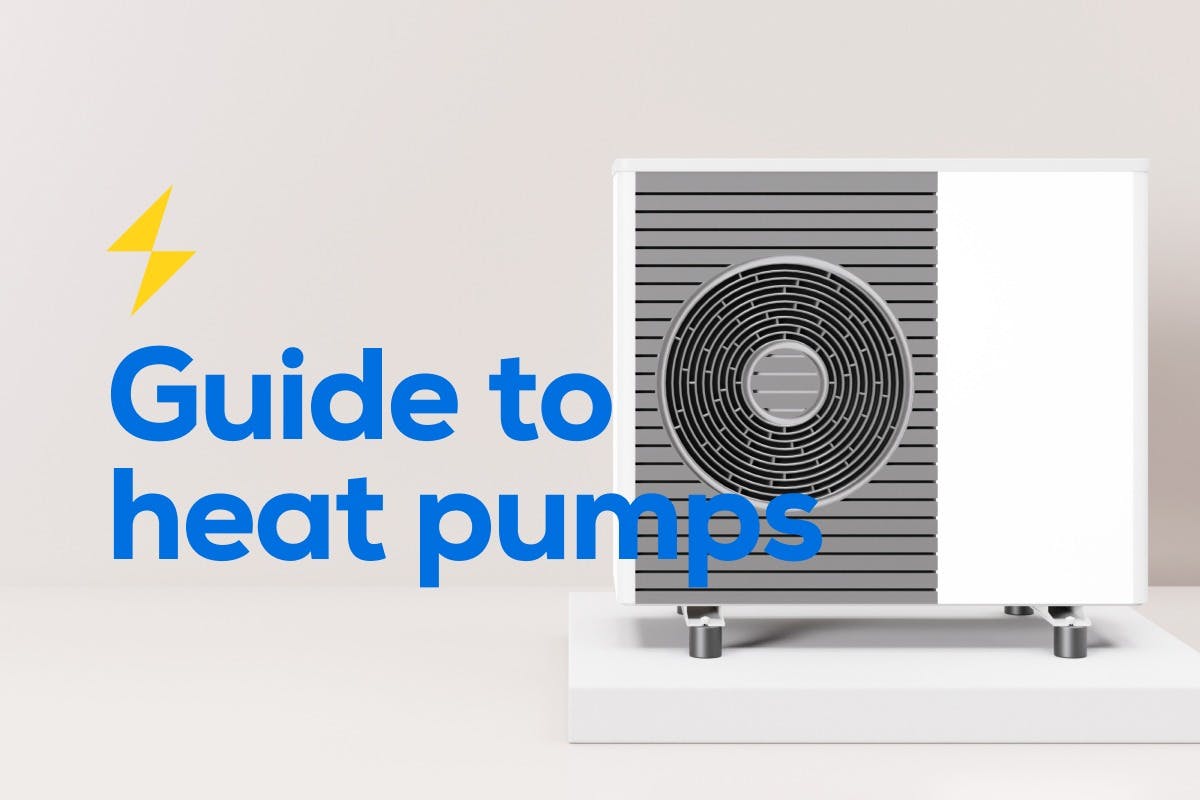Whether or not you are electrifying your home with solar power, heat pumps are another great residential upgrade to consider while attempting to cut back on your property’s fuel consumption and energy costs.
According to the U.S. Energy Information Administration (EIA), space heating and air conditioning account for over half of the energy consumption in an average American home, with a slight majority of residential spaces using natural gas.
As an alternative to traditional furnaces, space heaters, and even air conditioners, heat pumps are an energy-efficient appliance and an environmentally friendly way to reduce your natural gas consumption, while heating and cooling your home all year round.
In this guide, we will explain how heat pumps work, the different types of heat pumps available, their benefits, and what to consider when buying one to heat your home.
See how much you can save with home energy changes
What is a Heat Pump?
Heat pumps are versatile and energy-efficient heating and cooling appliances that are commercially available all over the world. Based on technology that dates back to the 19th century, heat pumps work by transferring or “pumping” thermal energy between the outdoors and your home to cool down or heat up your indoor space.
Most high-performance heat pumps work throughout the winter and summer, transferring warmth in or out of your home depending on the season.
How is a heat pump different from a furnace or an air conditioner?
As an all-in-one home heating and cooling device, heat pumps can provide the same results as both a furnace and an air conditioner. The functionality of heat pumps is also slightly different than furnaces and air conditioners, making them generally much more energy efficient than both devices.
While most AC units and gas furnaces physically create warmer or cooler air, heat pumps do not actively modify the air in a home. Instead, heat pumps simply absorb energy from the air from inside or outside of your building, and transfer that energy to the opposite location.
Different Types of Heat Pumps
When evaluating heat pumps, it is important to know what type you are purchasing, as different technologies can only work on certain properties. While every heat pump transfers thermal energy to move heat in and out of a house, the different kinds of devices are defined by the type of energy they use to supplement performance.
- Air-Source Heat Pump: Traditional air-source heat pumps are the most common type of heat pump, and operate by transferring heat between your house and the outside air. Air-source heat pumps can be paired with electric heat furnaces or a home’s electricity source to maximize performance. To stay sustainable, electricity-supplemented heat pumps work well with photovoltaic (PV) solar panels.
- Geothermal Heat Pump: Also known as GeoExchange heat pumps, earth-coupled heat pumps, ground-source heat pumps, or water-source heat pumps, geothermal heat pumps transfer energy between your house and the earth, rather than the outside air. Geothermal heat pumps work well in areas with extreme temperatures as the interior of the earth remains fairly constant at all times. With tunneling required, GeoExchange devices are usually more expensive to install than air-source heat pumps.
- Absorption Heat Pump: Relatively new to the market, absorption heat pumps are another kind of air-source heat pump, with the distinction of not using electricity to supplement performance. Instead, absorption heat pumps can use a wide range of energy sources in addition to ambient heat, such as natural gas, propane, solar-heated water, or geothermal-heated water.
How Heat Pumps Work
To help you better understand how heat pumps work, let’s break down a typical system and take a closer look at each of its components:
- Outdoor Unit: With an appearance often similar to a central air conditioner, the outdoor unit of a heat pump is typically installed just outside of a home. Used to draw in thermal energy, this component is built to withstand the outdoors and contains a fan, an exhaust, and a coil that acts as a condenser coil or evaporator coil.
- Indoor Unit: A heat pump’s outdoor unit is connected directly to the indoor unit within a home, usually located in a basement or on the first floor. The indoor unit also contains an evaporator/condenser coil to transfer heat and a fan to push the air through the ducts in your home.
- Refrigerant: Transferred between components in liquid and gas form, refrigerant is a chemical that gives off heat as it circulates throughout a heat pump system.
- Compressor: While fans are used to push and pull warm air in a heat pump system, the compressor pressurizes the refrigerant and movies it between the indoor and outdoor coils.
- Reversing pump: The reversing pump changes the flow of the refrigerant to travel in the opposite direction. This transitions the system between cooling and heating settings.
- Expansion valve: The expansion valve, also known as the expansion device, regulates the flow of the refrigerant as it passes through the heat pump, reducing its pressure and temperature.
Heat pumps heat or cool your home based on the direction and intensity that the refrigerant is traveling between your indoor and outdoor units. Within these components, the coils act as either an evaporator or condenser to properly transfer the heat in or out of a home.
Here, the distinction is fairly simple. When the refrigerant changes from a liquid into a gas, it evaporates and absorbs heat. When the refrigerant changes from a gas back into a liquid, it condenses and gives off heat. As such, the indoor and outdoor coils work as either a condenser or evaporator to transfer the heat into or out of an interior space accordingly.
Heat Pump in Cooling Mode
Despite being called a “heat” pump, these devices can also function like an air conditioner to cool down a home. While in cooling mode, heat is drawn from within the home to evaporate the liquid refrigerant in the indoor coil before pressurizing it and sending it to the outdoor unit.
The outdoor unit then condenses the refrigerant back into a liquid, which releases heat into the atmosphere. The liquid then passes through the expansion valve to reduce its pressure and cool it even further. This process is repeated until enough warm air has been displaced and optimal interior temperatures are achieved.
Heat Pump in Heating Mode
A heat pump's heating mode is essentially the same process as its cooling mode but in reverse. In this case, the reversing pump is activated to draw in heat from the outdoor air, rather than extract warmth from within a home. The roles of the evaporator and condenser are swapped, with the outdoor unit’s coil evaporating the refrigerant using exterior thermal energy, and the indoor unit condensing the gas and releasing heat into a home.
In both heating and cooling, the indoor unit’s fan is used to blow the warm or cool air throughout the home. Here, electricity or another power source can be used to speed up the process.
Coefficient of Performance or Energy Efficiency Ratio
The efficiency of a heat pump is determined by its Coefficient of Performance (COP) or Energy Efficiency Ratio (EER). This figure displays the ratio of useful heating or cooling that a heat pump provides, divided by the amount of power used to create it. For example, a heat pump with a COP of 10 delivers ten times as much heating or cooling as the amount of electricity it uses.
See how much you can save with home energy changes
Heat Pump vs Furnace
Able to provide warmth in cold conditions, heat pumps are an alternative to traditional natural-gas-powered residential furnaces which burn fuel, create hot air, and distribute it throughout a property. Usually housed in the basement or lowest level of residential properties, furnaces provide central heat through a home’s duct systems and are also often assisted with electric power.
The key difference between a heat pump and a furnace is a heat pump’s incorporation of evaporative cooling to extract heat from the air outside of a home. While this is limiting in extremely cold conditions, heat pumps do not burn any fuel while they are working to warm up an interior, and are typically installed with an electric furnace or “booster” to help in situations where the heat pump needs additional help heating the home.
Gas furnaces are much more powerful than heat pumps, which comes at the expense of efficiency since they also consume much more grid-supplied energy to function. In the United States, many initiatives are being made to update the efficiency standards for furnaces, and the state of California recently voted to eliminate natural gas-powered furnace sales altogether by 2030.
Pros and Cons of Heat Pumps
To help you decide whether or not a heat pump is the best choice for your property, let’s explore the technology's pros and cons when compared to gas furnaces, air conditioning, and other devices used to heat or cool a home.
Pros of Heat Pumps
As an energy-efficient, all-in-one device, there are many advantages that heat pumps possess over alternative HVAC systems:
Year-Round Versatility
When it comes to creating indoor comfort in any condition, heat pumps can cool and warm your home throughout the entire year. As a way to “kill two birds with one stone,” heat pumps can replace your entire heating and cooling system with one all-season device. This can help you save space on your property and simplify the way your home consumes energy.
Energy Efficiency
By capturing thermal energy from the atmosphere instead of burning natural gas, heat pumps consume less power than traditional furnaces, and are a much more efficient system overall. Heat pumps work best in warmer climates, but can still deliver up to 600% efficiency with higher coefficients of performance than gas heaters in most ordinary living scenarios.
Cheaper to Run
As furnaces require a lot of energy to heat a home, they can be expensive to run on utility-supplied natural gas. Since heat pumps simply transfer heat between the inside and outside of a property, the only expenses associated with their ongoing operation are electricity, which can be even further reduced with solar panels or another alternative energy source.
Energy savings vary depending on the season, as well as the local rates for natural gas and electricity.
Integration with Solar Panels and Other Renewables
As we just mentioned, heat pumps can be integrated with solar panels to deliver a completely emission-free, low-cost heating and cooling system. While you can’t always control the price or source of utility-fed electricity, generating your own power at home with solar panels can maximize your energy independence and minimize your carbon footprint.
Of course, specialty heat pumps can also use geothermal and other renewable energies to keep your home at a comfortable temperature without dramatic effects on your utility bills.
Quiet Operation
Although the difference can be marginal for some brands and models, heat pumps are generally less noisy than the average furnace or air conditioning unit. Heat pump systems are designed to minimize noise when in use, with an average operating hum of around 60 decibels outdoors and 18 to 30 decibels indoors. While some modern HVAC units also deliver similar noise levels, heat pumps are usually recognized as the quietest products on the market.
Compact Devices
Often mountable on the ground or wall, the indoor and outdoor components of a heat pump system are generally very compact and require less clearance than devices using combustible fuel. With dual functionality, heat pumps can provide all of the heating and cooling a property needs, thus saving space by replacing two appliances with one versatile unit.
Cons of Heat Pumps
Heat pumps do have a few disadvantages compared to high-performance furnaces, air conditioners, and other HVAC solutions.
Reduced Performance in Colder Temperatures
While heat pumps do heat homes with greater efficiency than furnaces, this is not always true when colder temperatures arise. As a heat pump operates by drawing heat from the surrounding outside air, if the conditions are too cold, the system cannot efficiently warm a home without drawing significant amounts of electricity or another energy source.
As a general rule of thumb, heat pumps begin to lose efficiency once the outside temperature drops below freezing. To be clear, the heat pump will still run, but it will start drawing more electricity than normal to operate, and it will take longer to warm up your home.
More Expensive to Install
The average installation cost of a furnace is around $4,400, depending upon the type, size, and whether it’s gas or electric. Slightly more expensive, the average installation cost of a heat pump is around $6,000. This increase is mainly because heat pump parts tend to be more expensive to purchase and also require more complicated indoor and outdoor installations.
Today, homeowners may be able to receive an energy efficiency rebate of up to $8,000 with the purchase of a heat pump from federal or local governments. It is also important to consider the lifetime operational costs of a heat pump system when comparing it to the long-term expenses of a furnace or AC unit.
Energy Dependent
As a less powerful alternative to AC units and furnaces, heat pumps still remain reliant on additional energy sources to quickly and efficiently heat or cool a home, especially in cold climate conditions. Knowing this, some heat pumps aren’t quite as cheap or green as they can be advertised if supplemented by an expensive, fossil-fuel-based energy source.
How to Shop for a Heat Pump
Heat pumps can cost thousands of dollars to install, so decisions should be made after a proper amount of research. Here are three of the main things to consider while shopping for your heat pump:
- Technology: As mentioned above, heat pumps can be installed in conjunction with electricity, gas-powered, or geothermal-fueled energy sources. Before you buy a heat pump, be sure to determine whether or not its technology is suited for your property and local climate conditions.
- Size: In addition to the physical size of a heat pump, you will also need to pay attention to its power rating. While you may want to cut down on the property space you need to sacrifice for the installation, you will also need to make sure that your device will be powerful enough to heat or cool your entire home. Undersizing a heat pump can lead to large temperature fluctuations and a higher dependency on electricity resulting in increased energy costs.
- Total Cost: Before you make a purchase, remember that the total cost of your heat pump includes both the buying price and the installation cost. This can vary heavily depending on the brand, quality, and size of your equipment as well as the availability, rates, and prices offered by certified, local installers.
The Best Heat Pump Manufacturers
When shopping for a heat pump for your home, we recommend working with a professional to help you select the best products and services for your unique project. If you would like to start browsing your options, there are many domestic and international heat pump manufacturers you can consider such as American Standard, Carrier, Mitsubishi, and Trane.
In addition to making the right decision based on technology, size, and total cost, we highly recommend paying attention to the warranty periods offered by today’s heat pump manufacturers. The longer a warranty period is, the more likely it is that you will receive a high-quality product. Long warranty periods will also protect you against future costs from malfunctions or damage.
Your Heat Pump Guide
Ultimately, heat pumps are a great, energy-efficient alternative to furnaces and traditional air conditioning or heating systems. While they still rely on energy supplemented from additional heat sources, especially in extreme weather conditions, heat pumps can significantly cut down on the costs to heat or cool your home and replace a natural gas furnace with a more environmentally-friendly solution.
To maximize your energy savings and minimize your carbon footprint, heat pumps paired with photovoltaic (PV) solar panel systems are one of the greenest and most efficient ways to heat and cool a home in the United States today.
If you are interested in integrating solar energy with your heat pump system, Palmetto can provide a custom solution, designed specifically for your property. To see how the panels will look on your roof and to learn how much you could save on your energy expenses, feel free to use our Free Solar Design and Savings Estimate Tool to get started.
See what home electrification can do for you:
 Cory O'BrienSenior Director - Growth Marketing
Cory O'BrienSenior Director - Growth MarketingCory brings over 8 years of solar expertise to Palmetto, and enjoys sharing that knowledge with others looking to improve their carbon footprint. A dog lover residing in Asheville, NC with his wife, Cory graduated from UCSB. If you run into him, ask him about the company he founded to rate and review beer!

